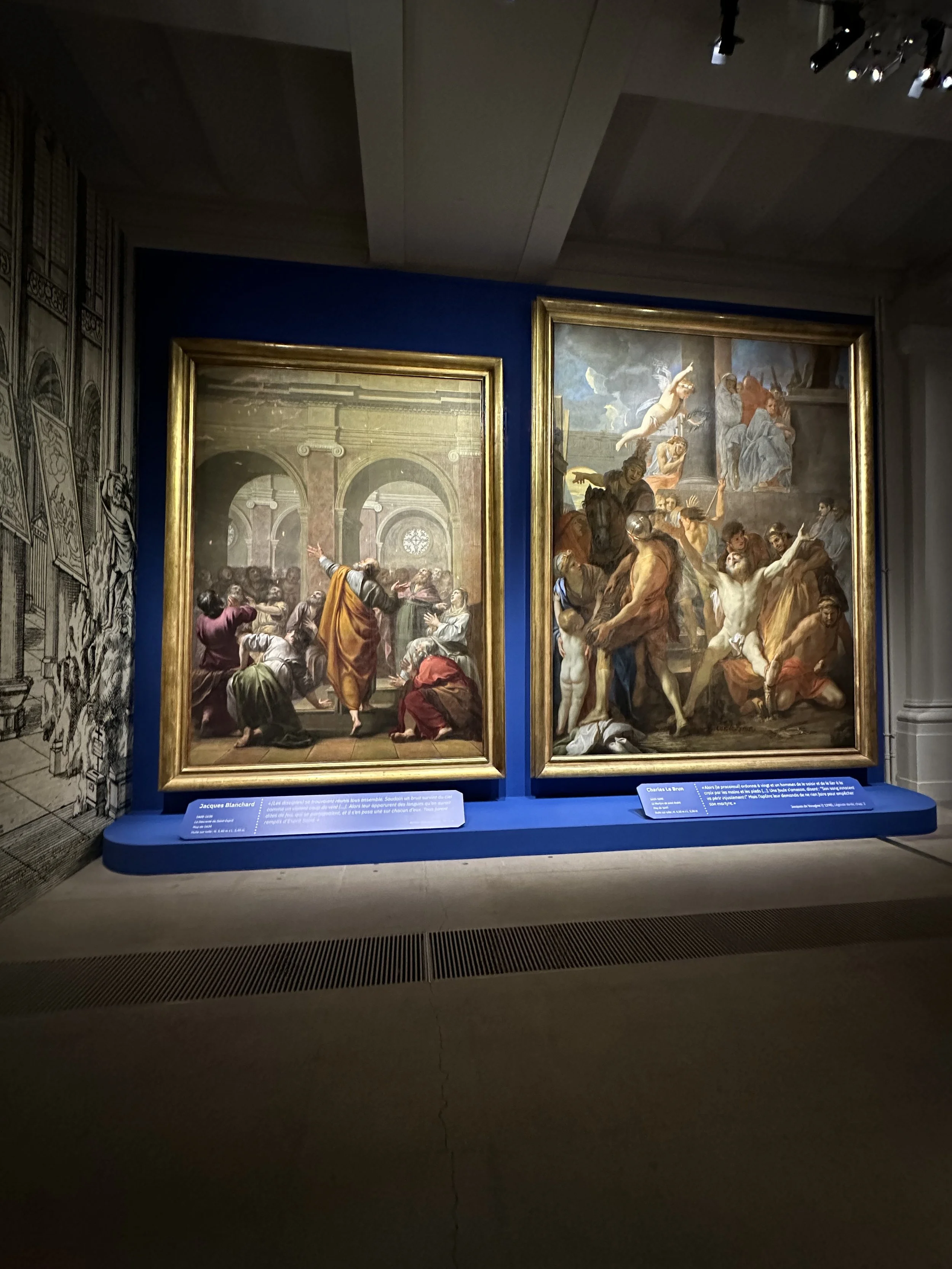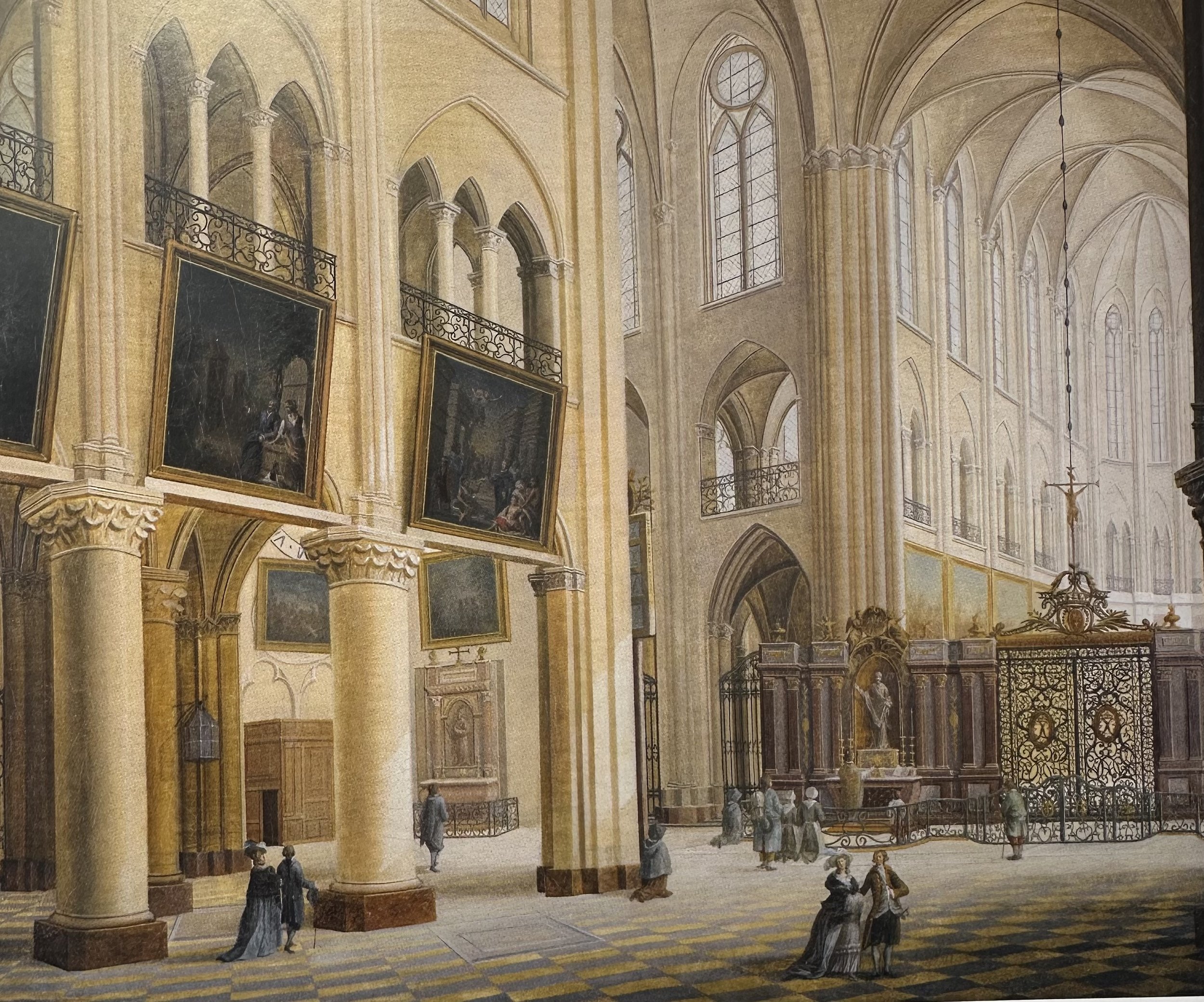In the 17th & 18th centuries, the Goldsmiths Guild of Paris donated a large painting to Notre-Dame de Paris these were known as the Les Mays. Given on the 1st of May between 1630 and 1707, with the exception of the years 1683 & 1694.
The tradition goes back to the 15th century, in 1449 when the Goldsmiths donated a tree covered with ribbons that was planted in front of the high altar and later in front of the rood screen of Anne of Austria. However, it was the 17th century when it was decided that a large painting would be given.
The Goldsmith Guild of Paris
In 1482 the Campagnons du May combined to create the Conference of Sainte Anne & Saint-Marcel. By 1620 Anne of Austria was named president of the guild. From 1604 - 1608 they had Petits Mays commissioned that would hang in the tabernacle of Notre Dame. In April of 1630 a larger donation was decided on that would include a towering painting.
Each year a different set of two masters of the brotherhood selected the painter a year in advance and the leaders of Notre Dame selected the theme for the year. A sketch was then presented to the leaders and if approved they would have a year to complete. The masters also selected the size of the painting which was on average, 15 by 11-foot- painting. The commission also included a sketch, two reductions of the painting, and the final canvas.
The art, stained glass, and sculptures in churches and more importantly the facades were to teach the people the Bible’s stories. Since many couldn’t read it was the way they could impart the lessons of the church. Each of the paintings was also an intersection of the word of God, image, and meditation.
The churches were the first museums. The Catholic church had so much money that they were also able to establish a massive collection. This is why a church in France should never be passed without a pop inside to look at the walls.
The Mays include a collection of 76 paintings created between 1630-1707 except 1683 and 1694 due to budgetary issues. At one time they were all in Notre Dame and must have been a sight to behold.
Themes of 1630 - 1670s Acts of the Apostles, 1670s to 1707 the Gospels. Each year the painting was accompanied by a poem or sonnet and a wish for the King. After 1655 an explanation of the paintings was also written and sold. Oh, to get my hands on one of those!
Today they are scattered throughout France and I have a mission to see them all. When Notre Dame reopens on December 8, 2024, the 13 paintings will return to the west walls of the designated chapels. In the north of France at the Musée Beaux-Arts in Arras are 14 in the Salon des Mays. The Louvre has 7 but only 2 on display and then 18 others are at other churches and museums in France except one in England, give it back!
The Life of Christ is featured in 22 of the paintings. Saint Paul in 18 and Saint Pierre in 16.
Each year at Midnight on April 30 the painting was hung in the chapel of Sainte Anne. Sainte Anne was the mother of the Virgin Mary but more so she is associated with the Queen. At 10 am on May 1, the painting was hung near the statue of the Virgin on the Rood screen that stretched across the center of the church. Remaining on the pillar until the 1 of Juin, they would move to high above the nave.
Artists chosen from the Royal Academy, many up and coming would have the opportunity for their art to be on permanent display, long before there were any museums. At first, they wanted mostly unknown painters but once the Academy was created in 1648 the royal artists were looked at first. Charles Le Brun who created the Academy painted his first at just 28 years old in 1647. His second was in 1651 and both remain in Notre Dame.
Amazing painters of the day, Charles Le Brun, Jean-Baptiste de Champaigne, Noel Coypel, and Eustache Le Sueur are just a few of the names that created these great works for Our Lady. Lubin Baugin received between 1645 and 1655 an order of 19 paintings from the Canon Michel Le Masle to be placed in the choir as well as the commission to create a set of tapestries dedicated to the Life of the Virgin.
60 artists over the 76 years. 12 of which did two separate years and one, Aubin Vouet painted three.
The War of Succession and the restoration of Notre Dame by Robert de Cotte ended the yearly Mays and much of the decoration that filled the church.
The Goldsmith Guild was dissolved in 1732.
During the Revolution, the Church fell out of importance as it had been so tightly aligned to the King. Notre Dame became the Temple of Reason and a storage facility. On December 16, 1793, all of the paintings were removed from the Cathedral and deposited to the depot of Petits Augustins before they were deposited in the newly opened Musée Central des Arts, aka Le Louvre. The collection of Notre Dame was sent to Versailles or the Musée de Monuments created by Alexandre Le Noir in June of 1798 where a few were restored and stayed until 1802.
On August 15, 1801, Napoleon and Pope Pius VII came to an agreement with the Treaty of the Concordat. The 39 articles returned the churches to the Holy See with more of an involvement with the government who would even choose the leaders. Many of the priests refused to sign the agreement which saw them sent off to an early retirement by Napoleon. This act thankfully returned the art to Notre Dame in 1802. Sadly some were sold or even lost and destroyed.
Napoleon added five paintings to Notre Dame he “liberated” from Italy, all returned to their origin in 1815. Axial chapels changed in 1818 and the paintings were all given a more permanent position.
Eugene Viollet-le-Duc and Lassus were selected in 1845 to restore the cathedral that was so badly damaged during the Revolution and at one point the government tried to sell it off for the stones. Under Viollet-le-Duc, he removed all of the paintings, 42 in total as he felt they didn’t go with his painted murals of the chapels he created. He later brought 13 paintings back.
The paintings were forgotten after the Revolution and after Viollet-le-Duc had them removed until the 1940s when Pierre-Marie Auzas brought them back to light in his book and gave a renewed interest in these works of art. In 1947 the interior life of the cathedral was inspected and studied
An exhibit at the Sorbonne featuring the “Les Grandes Heures de Notre-Dame de Paris” 1947
1949 Auzas brought 4 of the Mays back from the Louvre 1635, 1643, 1649 & 1651
Auzas did a meticulous investigation of the church and chapels to bring the objects back to the cathedral Under Auzas plaques were added in chapels. Until the fire, the plaques were the best I have ever seen in a church. Information on every single item in the chapels. I hope they return, especially since the entire layout is changing.
1963 14 Mays in the church for 800th anniversary
1983 Le Sueurs May went to the Louvre for an exhibition and never left. The Louvre has 8 in the collection but only two are currently on display, Coypel’s Saint James the Great led to Martyrdom and Le Sueur’s La Prediction de Saint Paul Éphèse. The other six are in a horrible state and hopefully will be restored down the road.
Check out the exhibit of the paintings at the Gobelins until July 21 or check out my video on YouTube. Next week we will do a deep dive into the paintings and restoration efforts themselves.





